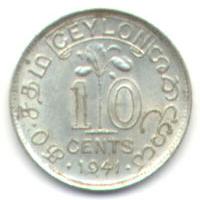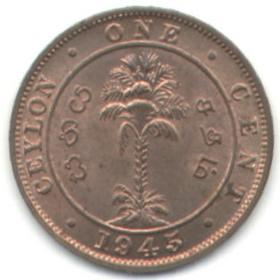





The 5 rupee and 2 rupee coins which were of Nickel-brass and cupro-nickel, since they were first issued in 1984 have been changed to brass and nickel plated steel coins. Such a change occurred in 1996 for the 1 rupee, 50 cents and 25 cents coins when they changed from cupro-nickel to nickel plated steel coins. This change was hardly noticed by the public since the weight, size, shape and color of the coins remained unchanged. The change can however be noticed by the attraction of the newer steel coins to a magnet. The new 5 rupee and 2 rupee coins which is the same size at 23.5 mm and 28.5 mm in diameter are however 19.0% and 15.6% lighter in weight respectively than the current coins.
| The new one rupee brass plated steel coin with an alternate milled and plane edge is 20 mm in diameter and 3.65 grams. It is smaller in both size and weight then both the current 1 rupee coin at 25.4 mm and 7.13 grams and current 50 cent coins at 21.5 mm and 5.51 grams. | 
| 
|
| 7.13 gms 25.4 mm | 3.65 gms 20.0 mm | |
| The new 50 cent copper plated steel coin with a milled edge at 18 mm in diameter and 2.5 grams is the same diameter but lighter than the current 25 cents which is 3.24 grams. | 
| 
|
| 5.51 gms 21.5 mm | 2.50 gms 18.0 mm | |
| The new 25 cent copper plated steel coin with a plane edge at 16 mm in diameter and 1.68 grams is the same diameter as the current aluminum 1 cent coin which does not circulate. | 
| 
|
| 3.24 gms 18.0 mm | 1.68 gms 16.0 mm |
The diameter of these low denomination coins have reduced by about 20% and the weight by about 50%.
The smaller aluminum 1, 2, 5, and 10 cents denominations will not be issued. They were last minted over 10 years ago in 1994, 1978, 1991 and 1991 respectively. Although still legal tender they are hardly seen in circulation and rarely issued by the Central Bank since the cost of minting them and even the scrap value of aluminum far exceed the face value.
It is rarely that any country changes the size or shape of currency in circulation. Most denominations have had a changes to cheaper metals and became lighter, some were demonetized and withdrawn from circulation but the size and shape remained the same. The Central Bank has over the years issued commemorative coins of varied size and shapes. Three regular issue coins changed size on 2005 Dec 14th. However there has been only three other significant changes in the size or shape of a coin since decimal currency was first issued for Ceylon back in 1870.
| The Queen Victoria copper round 5 cent penny size coin 34 mm in diameter and 18.9 grams in weight was demonetized effective 1910 July 1st and replaced in 1909 with a much smaller square cupro-nickel 18.5 mm in width, 3.88 gram coin. | 
| 
|
| 18.9 gms 34.0 mm | 3.88 gms 18.5 mm | |
| During WWII the George the Sixth silver round 10 cent coin 15.5 mm in diameter and 1.116 gram in weight was demonetized effective 1943 February 28th and replaced in 1944 with a 6 scallop nickel-brass 23.1 mm in diameter and 4.21 gram coin. | 
| 
|
| 1.116 gms 15.5 mm | 4.21 gms 23.1 mm | |
| The George the Sixth copper round 1 cent coin 22.5 mm in diameter and 2.362 gram in weight was removed from circulation an replaced in 1963 with aluminum cent 16 mm in diameter and 0.70 gram coin. | 
| 
|
| 2.362 gms 22.5 mm | 0.70 gms 16.0 mm |
Inflation causes the value of the rupee to go down by a factor of 10 about every 22 years. i.e. a factor of a 1000 in 66 years. Foe example in the early 1940's a gold sovereign was worth about Rs13/= and now it is over Rupees13,000/-. When the quarter cent was demonetized in 1910 and the half cent in 1941 they were worth about 5 current rupees. Practically all items are now priced in whole rupees. One rarely sees fractional rupee coins in circulation in Lanka since even bus fares use whole rupee prices. Change of even a Rupee is not often returned and ignored. Fractions of Rupee are now hardly of any value and even a beggar will probably scold you if you give one. With cost of minting Lankan coins is now much larger than face value, it is probably time now to get rid of all cents coins in Lanka. It seems to me that a new 25 cent and 50 cent coins have been issued long after they should have been removed from circulation.
The difference between the face value of coins and the local value of the metal they contained plus the cost of minting the coins is known as seignorage and represents the profit or loss to the Bank issuing the coins.
Until just before WWII the face value of coins was only slightly more then the local value of the metal they contained. The difference paid for the cost of minting the coin. Copper coins were large and heavy. In Ceylon Denominations above 10 cents were minted in Silver. To simplify physical transport of large amounts of money, currency notes were issued with a Promise to pay the bearer on demand with reserve gold and silver stocks held in the Bank.
In 1941 during WWII after the Ceylon Government was no longer able to back the currency it printed with silver or gold. The statement of currency notes change to say they were legal tender for the payment of any amount, and the Silver coins were demonetized and replaced first with fractional paper currency notes legal tender for payment of a sum not exceeding Five Rupees and then later with Brass coins.
As the value of Brass in the coins which were introduced during WWII cost more than face value, they were replaced first by Aluminum and Cupro-Nickel in 1963, and 1978, and more recently in 1996 by nickel plated steel.
Coins last 10 times longer than currency notes which in few years gets dirty and torn and needs to be replaced. If most coins returned to the Bank, then their would be no need to mint more of them. However very many of them get saved in large hoards in boxes that collect offering at places of religious worship, or even in the homes of the public who see little value in returning them.
A newspaper advertisement by CBSL on 2005 January 2nd, called for Expression of Interest for minting and supply of Sri Lanka Coins. The tender to mint the Rs 427.5 Million of 2005 coins was awarded again to the Royal Mint in UK which has minted most of the Sri Lanka coins since 1959.
With Electronic transfers for many transactions we are heading toward a coin and currency less society. However that is in the distant third world future.
Author maintains an educational website on two thousand years of Lankan coins at http://coins.lakdiva.org.lk/, and is a life member of the Sri Lanka Numismatic Society.